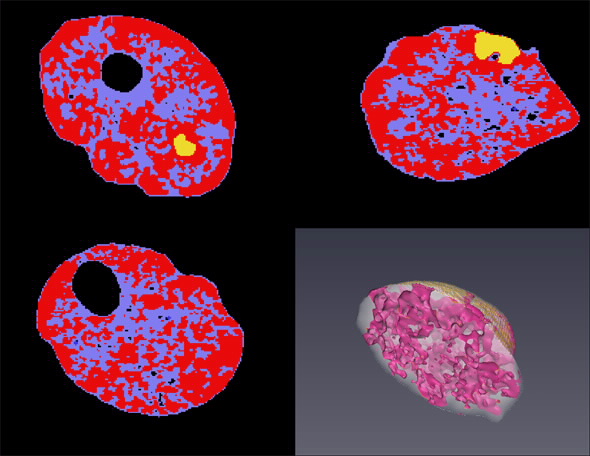ANSTO’s versatile neutron instrument Dingo was used to analyse opalised pearls more than 65 million years old that were found in Coober Pedy, South Australia.
In addition to confirming that the samples were ancient pearls, Dingo produced three-dimensional computerised tomographic (CT) scans of the objects for the South Australian Museum.
Instrument scientist Floriana Salvemini said the neutron tomography allowed the reconstruction of the internal structure of these rare objects without damaging them.
 |
| Cross sections along three directions of an opalised pearl on Dingo instrument. The 3D tomographic reconstruction appears in lower right corner. |
“The analysis provided evidence of a non-perfectly concentrically-ringed structure of the pearl which would originally have been made of layers of calcium carbonate and nacre. The red and blue zones in the neutron tomograph images (pictured) represent variation in hydration and porosity of the layers, now all completely replaced by opal.
“The blue zone in particular is characterized by high porous and low or absent concentration of hydroxide. On the contrary, the red areas represent layers with a higher water content and low microporosity. Supported by complementary measurements, we can conclude the yellow spot can be interpreted as a grain of pyrite associated with H2O-bearing sulphates,” said Salvemini,
The world's first record of opalised pearls, relics of creatures in an ancient inland sea dating back 65 million years, were unearthed by two miners in the South Australian outback.
The scientifically "priceless" four-millimetre specimens were found in the Coober Pedy opal fields, an area which is famous for the colourful gemstones.
Dr Ben Grguric from the SA Museum, where the pearls have gone on display in an opals exhibition, said opal miners Dale Price and Tanja Burk were sorting through a spoil heap when they made the discovery.
"The miners pick out anything that glows with ultraviolet light, because even a small chip of opal might be worth something if it's high quality with a high range of colours," Grguric.
"It turns out these resembled pearls."
He said there were a lot of shell fossils in the Coober Pedy region, and those with a sharp eye may come across more opalised pearls in the future.
 |
| Photo: South Australian Museum |
He said opals formed when seas dried up and alkaline soil dissolved the silica in certain rocks, as well as bones and shells - and in this case, pearls.
"A lot of the opal fossils, including bones and shells, were formed during the cretaceous period, which was an era earlier than 65 million years ago and the age of the dinosaurs," Grguric said.
"We decided to use a technique called neutron tomography, which is like a CT scan using neutrons," Grguric said to the media.
"They established there was a concentric structure which is consistent with pearls as we know them today."
The pearls are still owned by Mr Price and Ms Burk, and only on display for a short time at the SA Museum.
"It's difficult to put a price on them, and from the point of view of a gem they're not particularly valuable," Grguric said.
"But from a scientific view, you'd argue they were priceless."
The Dingo instrument, one of the highest intensity technologies in the world, is used regularly for analysing cultural artefacts, paleontological and archaeological specimens as well as industrial samples.
The name of the research reactor, OPAL, that produces neutrons for the instruments is an acronym for Open Pool Australian Lightwater reactor.
This article was adapted from media reports which appeared in the Adelaide Advertiser and on the ABC online.
Published: 08/02/2016


